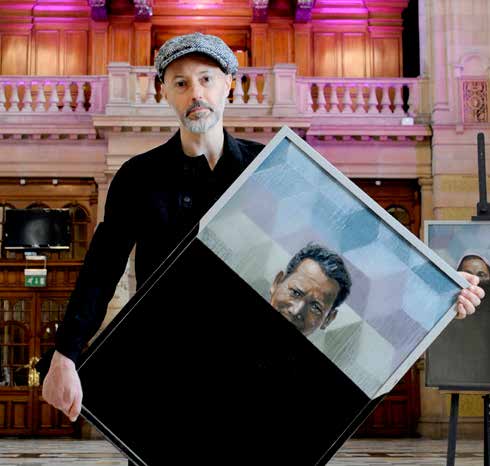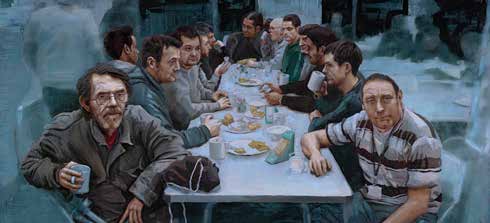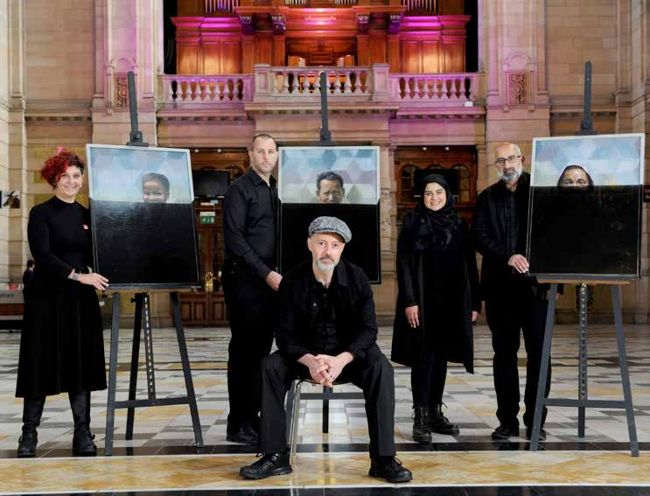‘I knew that I couldn’t not follow Jesus’
Jackie Macadam meets artist Iain Campbell and learns about his work and faith.
“HAVING zero interest in football (the only sport that existed in Linwood) was not really socially acceptable, so it did help to have something else to be known for.
All the kids in class knew that I was the one who was quite good at drawing….”
Iain Campbell has produced some incredibly memorable artwork on behalf of the Church of Scotland. But it’s only recently he’s been able to apply himself to art full-time.
“I was born in Paisley in 1975 and grew up in Linwood which, for the majority of my childhood, in those dark, Thatcherite days, was a factory town with no factory.” He told us.
“Dad was made redundant from the Rolls Royce factory in Hillington in 1982, the same year Linwood’s car factory shut down. There was no shame in your dad being unemployed at school, everyone’s dad was unemployed. My best friend at school, Ross, was considered weird when he was the first kid in the class not to be on free school meals after his dad got a job…..
“Although my parents were married in the Church of Scotland, they had stopped going before children came along. I was always quite taken by the weekly services the local minister held in our primary school. I really wanted to feel the prayers, for them to mean something for me, to feel that connection to God.
“Going to church never occurred to me as a young child, but when I was 15, Ross (the one with the employed father) invited me to a Christian youth group, where I made lots of new friends and was inspired by the kind leaders who were very committed to following Jesus. I went along with them to hear Billy Graham speak at Celtic Park and felt compelled to walk forward towards the end of the altar call.
“However, I remember deciding that night that I couldn’t be a church-going Christian, it was too hard to be the only one in my family. I remember feeling fear at what my parents might think or say.
I continued to go to the youth group though, and that summer, feeling jealous of my friends with God in their lives, I knew that I couldn’t not follow Jesus”.
Art was Iain’s passion. He spent endless hours copying pictures from The Beano and his Batman annuals and using household items to create space ships and mission bases for his action figures.
He laughs at the memory.
“I think every cornflakes box and toilet roll tube were utilised as sources of cardboard!”
Portraiture gripped him once he got to school.
“I really like drawing and kept on practising. In high school, I really got into portraits. If there were no other resources to draw, I could use a mirror for selfportraits. One art teacher in particular, Greta Vipond (sister-in-law of Dougie Vipond from Deacon Blue and a BBC presenter) was a great help. She brought a small group of senior pupils along to evening portrait-drawing classes at Paisley Arts Centre. The environment stretched my confidence and capabilities.
“I did well in school, but always had a nagging feeling that I should have been doing better,” he says. “I didn’t know that I was dyslexic until I was 28. Ten percent of the general population are dyslexic but two places where you’ll find the highest concentration of dyslexic folk are art school (30%) and prison (50%). There are an incredible number of folks, like me, pedalling twice as fast to keep up.”
And it was at Glasgow School of Art that Iain found his ‘spiritual’ home.
“Glasgow School of Art beckoned after high school (rather than Barlinnie) and I dived into the creative soup of that world. I met my wife, Amanda, there apart from anything else! GSA in the 1990s was a real inspiration, alumni like Peter Howson and Jenny Saville were blazing a trail in figurative painting. I was in awe of their work. Howson’s paintings of the war in Bosnia affected me deeply. The Roger Bilcliffe Gallery, just off Sauchiehall St exhibited them, the gallery staff rolled their eyes at the likes of me coming in to see the work again and again. It was so raw, so poetic, so painful. I vowed that if I ever had the chance to do work like that and explore the world of pain and grief that people were going through, I would jump at it.”
Iain’s chance would come to follow in Howson’s footsteps a little later when he completed a memorable series of paintings remembering Srebrenica.
“The opportunity to visit Bosnia with Remembering Srebrenica Scotland brought my memories back to seeing Peter Howson’s Bosnia War paintings back when I was a student. It was in November 2019 that I went with a delegation from Scotland to visit Sarajevo and Srebrenica, to learn first-hand about the genocide.

Iain Campbell
“Although my parents were married in the Church of Scotland, they had stopped going before children came along. I was always quite taken by the weekly services the local minister held in our primary school. I really wanted to feel the prayers, for them to mean something for me, to feel that connection to God.
It was the worst massacre in Europe since the Holocaust. More than 8,000 Muslim men and boys were killed.
“It was very humbling to meet the survivors that I painted, to hear their stories and to share them in a way that people in Scotland can relate to.
Remembering Srebrenica’s main aim is to help people understand where hate and intolerance lead. It’s a stark warning for the times we live in and all too relevant today.”
One of Iain’s most famous pieces is a huge portrait of thirteen men, entitled ‘Our Last Supper’. That came about thanks to a unique collaboration with Glasgow:
St George’s Tron.
“After graduating from Glasgow School of Art, I did some freelance illustration work while I was in my youth-work career.
“In 2013 I had my first solo exhibition of portraits, Man of Sorrows, at St Mary’s
Cathedral in Glasgow. They had previously exhibited Howson’s Stations of the Cross and were keen to explore having further exhibitions.
“I remember how nervous I was before taking the paintings over to hang the exhibition. I seriously considered cancelling the whole thing. I’m glad I didn’t as it was a springboard to everything else that followed on. Even when you’re scared to do something, you just need to plough ahead.
“I had got to know Alastair Duncan, the minister at St George’s Tron, when he was at his previous charge at Garelochhead.
When he moved to Glasgow, he came to the exhibition I had at St Mary’s Cathedral. We started meeting for coffee and I casually mentioned that my dream job would be as an artist-in-residence in a church. The next time we met, he had thought about this dream of mine and suggested we tried to get some funding to make it a reality. The excellent (and very missed!) Go For It fund had grants for pilot projects and we applied for the funding.
“The history of art in the Church of Scotland was mostly getting rid of it all 400 years ago! Without the groundbreaking pilot-funding scheme of Go For It, I don’t think it would have been possible for the project to be funded.
There is so little understanding of visual art in the Protestant church.
“The funding was in place in 2014 but we had to wait a whole year until the café was ready to open to start the painting in the autumn of 2015. The café and the artist-in-residence role went hand-inhand, we didn’t want the painting to begin without it happening publicly.
“Alastair and I wanted the project to have a visual impact in the café, to make people curious about what was going on, and to speak about the partnership the church was developing with Glasgow City Mission. We wanted something that would connect the work of the café during the week with what was happening in the congregation on a Sunday. The project managed to do all of these things.
“I decided that if I was only going to get one shot at being an artist-in-residence in a church, I really wanted to paint a last supper. For me, the last supper is the core image of Christianity. It is with friends, round a table, eating that Jesus said that he wanted to be remembered, rather than in the isolation of the cross. I think lots of people think that the Alpha Course invented the idea of church as a meal with a conversation, but Jesus got there first.
This too was the model for St George’s Tron’s main service of the week: a Sunday service that started at 12:30 with a buffet lunch and then continued with the congregation remaining round tables as the worship music began.
“I had so many ideas about the composition of the painting, there were lots of sketches about how figures could be arranged. In conversation with Alastair, he suggested just going down to the mission with my camera and seeing what happened next.”
Iain didn’t even dream about the impact ‘The Last Supper’ would have.
“It changed my life,” he says. “It was the first big, public piece of work I did. It was painted in the Wild Olive Café in St George’s Tron Church of Scotland in Glasgow, one day a week over 16 weeks.
The café had only just opened in the church and people who came in were fascinated to see someone painting live. Not only was I happy with how the painting turned out on a technical level, but the interaction it created within the church and café was incredible.

The Last Supper
The painting made sense to people, that it was simultaneously a group of folk eating at Glasgow City Mission and also an interpretation of the final meal Jesus had with his disciples.
“Again and again, I was asked “which one is Jesus?” as I painted. I deliberately never answered that question in the way people wanted to know. Matthew 24:40 was always on my mind as I painted, “Truly I tell you, whatever you did for one of the least of these brothers and sisters of mine, you did for me.” Whenever the poorest folks in our communities are in front of us, Jesus is there.”
In an incredible turn of events, Iain remembers a man approaching him while he was painting in the café one afternoon. “The most startling conversation I had when I was working on the painting was with one man, probably ten years my senior.
“He said: ‘The café staff said you might know my son. He’s missing and I’ve been looking for him.’
“When he told me his son’s name, I replied that I did, and was in the middle of painting the young man’s face….”
The painting caused a media storm and Iain was in the middle of it.
“In December 2015, the story of the painting reached the press. Co-ordinated by the media team at the Church of Scotland offices in Edinburgh, we had the BBC, STV, and Press Association all visiting on the same day. I lost count of the number of newspapers that the story reached, as well as all the Scottish papers it reached online media like Buzzfeed and Huffpost. It’s a funny thing to be in the middle of being picked up in a little blizzard of media attention, just as strange is the experience a week later, when nobody is that interested anymore, and you bump down to earth. I’m glad that I was forty and not twenty having that first media experience, I think it would have been a little overwhelming if I was younger.

“Iain Campbell (centre) with three of his portraits that were dipped in black paint as a work of protest art in advance of the COP26 climate conference in November 2021. With (from left) Sally Foster-Fulton of Christian Aid, Graeme McMeekin of Tearfund and Maria Zafar and Nadeem Baqir of Islamic Relief UK. Picture by Colin Hattersley
“The pilot project led on to a three-year residency, funded by Go For It, the Scottish Bible Society, and a number of other funders. During the three years, I worked on a series of 24 paintings, one for each chapter of the Gospel of Luke. As the project went on, the deeper the paintings were an embodiment of the community of people in the café and church. In the beginning of the project, I had ideas for paintings and looked for people who could be models within the community, but as time went on the stories of people I met lent themselves to intertwine with the stories from the Gospel of Luke.
“Professor Alison Phipps, the UNESCO Chair in Refugee Integration through Languages and the Arts, invited me to become part of their network of affiliate artists while I was working on the threeyear residency at St George’s Tron and through the UNESCO RILA network that the portraits for the Royal Society of Edinburgh came about. Alison Phipps is a fellow of the RSA and came up with the idea of the series of portraits of their members who are from refugee backgrounds.
“The RSE has a huge collection of portraits painted of their members from Sir Walter Scott to Professor Peter Higgs, of Higgs-Bosun fame. I was thrilled that they, with such a rich history, wanted to point toward Scotland’s future as a diverse, global thinking country, with these commissions.”
The future looks interesting for Iain. “I’m working towards a number of exhibitions of paintings, including one in The Lemond Gallery in Bearsden this summer and whilst working on the COP26 project that was exhibited at Kelvingrove, Christian Aid had me working on another climate focussed painting. It will be unveiled in a well-known building in Edinburgh at some point this year!” ¤